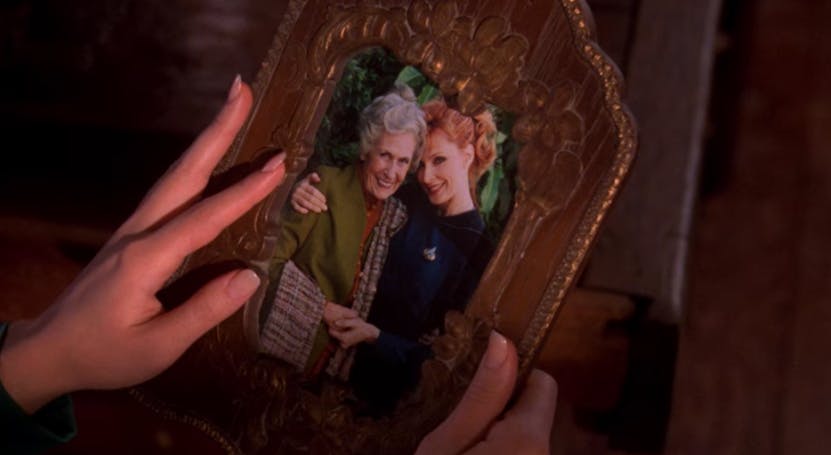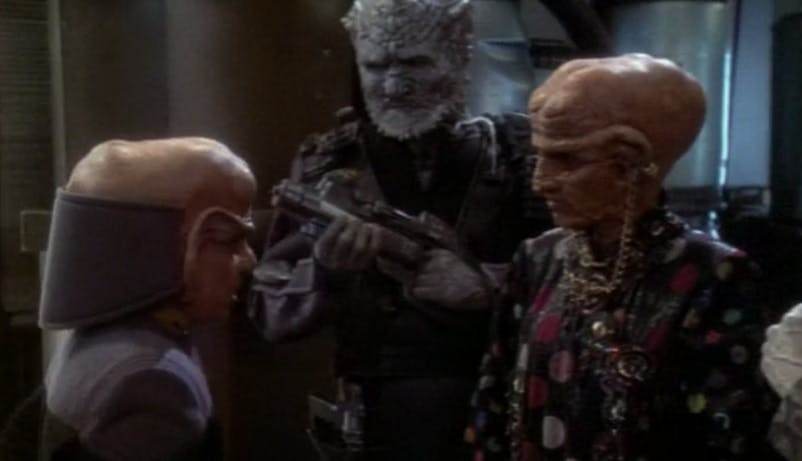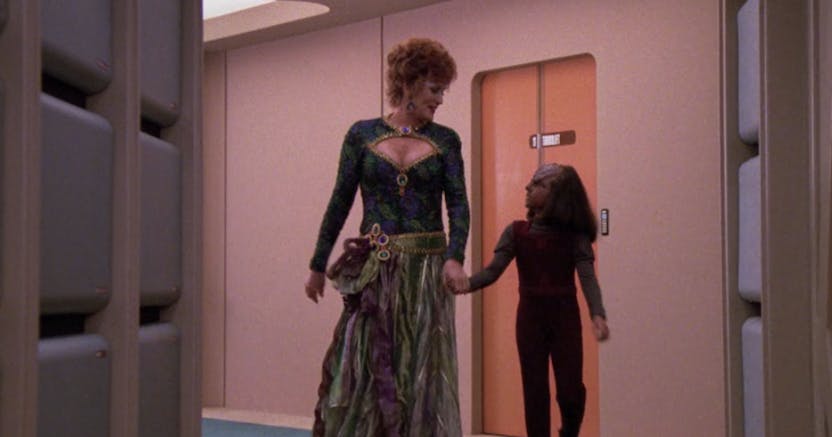Published May 9, 2021
Honoring Star Trek’s Grandmothers for Mother’s Day
Star Trek: Golden Girls is the next series, right?

StarTrek.com | ShutterStock/Somen/KatMoy
Grandmas are special. They’re often a safe haven, a sheltered harbor in the storm of childhood and adolescence – a harbor with too much candy and sleepovers, and the cozy protection of someone whose love has had two generations to grow. These maternal figures are not common characters in science fiction and fantasy, kept outside the realm of space battles and epic quests. But, as usual, Star Trek breaks the mold, routinely featuring and referencing these indomitable forces with love and admiration. We learn about T’Pol and Janeway’s famous ancestors. Keiko recalls a beautiful memory of her obachan teaching her Japanese calligraphy. B’Elanna offers up a poignant Klingon prayer to her grandmother, L’Naan, for the first time since childhood.
The stories of these relatives are a tender guiding force within the Star Trek universe, in addition to the grandmothers seen on screen: Helena Rozhenko, Felisa Howard, Ishka, and Lwaxana Troi. Though seen only briefly, and rarely or never with their grandchildren, their presence is keenly felt and their influences are strong throughout their family lines. These four noble, loving, trailblazing, intelligent grandmothers left indelible marks on the universe, its characters, and our hearts, exemplifying what makes Star Trek so powerful – truth and humanity.
Helena Rozhenko

StarTrek.com
It takes an exceptional Human woman to raise a Klingon child. To happily take up the challenge a second time requires the no-nonsense kindness of Helena Rozhenko. After Worf’s biological parents were killed on Khitomer, he was rescued by Sergey Rozhenko and raised by he and his wife Helena. They treated Worf like their own, supporting him in school, sports, and his career in Starfleet. Helena never balked at raising a Klingon; she merely saw a child in need and rose to the task, learning about his culture and cooking Klingon meals.
Worf’s parents also care for his son Alexander for some time after K’ehleyr’s death. Helena again sees a grieving child in need and is thrilled to have her grandson with her, but struggles to raise him as an older mother and eventually brings Alexander home to his father on the Enterprise. Helena knows that to keep them apart would not be in either’s best interest, although their relationship will not be easy.
Alexander never becomes the fiercest Klingon warrior, but he remains close to his grandparents and gleans his crucial honor in large part from the fierce Human woman who tackled the challenge of two Klingon boys. Though this hybrid of influences in childhood caused both Alexander and Worf to struggle to reconcile their true natures, this fusion ultimately helps them grow into more interesting, compassionate, and successful individuals.
Felisa Howard

StarTrek.com
Like Worf, Dr. Beverly Crusher lost her parents as a child. Her paternal grandmother, whom she called Nana, raised her and had a profound influence on her life and profession. Young Beverly and her Nana both survived the disaster on Arvada III and helped tend to the injured in the aftermath. Felisa was not a trained physician, but she discovered how to utilize the colony’s indigenous roots and herbs when the medical supplies ran out, using her compassion, ingenuity, and probably her cooking skills to improvise under extreme duress. Felisa could have left it to the medically skilled among them, but her sense of ethics and humanity wouldn’t let her ignore those in need.
Arvada III was a defining experience for Beverly and she applied these skills and tenets throughout her career. As CMO, Dr. Crusher develops treatments for innumerable new diseases, is the first non-Trill to study the species and perform a symbiont transplant, and is instrumental in saving the Borg drone that becomes our beloved Hugh. Felisa’s healing touch and stubborn compassion imbued high ethical standards in Beverly that lead to her successes, but also to disagreements with Captain Picard in which she puts the lives and health of others above Starfleet’s Prime Directive.
Unfortunately, Felisa’s only appearance on screen is for her funeral in “Sub Rosa,” but, as Beverly eulogizes, her healing, advice, and inspiration were instrumental in shaping those around her. Her current friends and neighbors clearly love and respect Felisa as a healer and a friend … young ghost-candle boyfriend notwithstanding. Good for you, Nana.
Ishka

StarTrek.com
Quark and Rom’s mother, Ishka, is not a “good Ferengi.” She earns massive profits, travels off-world, and wears fanciful clothes – all things that make a Ferengi a Ferengi, but which are illegal for females. In order to be a good Ferengi, she has to be no Ferengi at all.
Ishka’s grandson Nog is also not a “good Ferengi.” He knows he would be an unsuccessful businessman, so he wants to join Starfleet. He doesn’t want to be denied opportunities to shine, like his father was denied the chance to thrive as an engineer. In a heartbreaking speech to then-Commander Sisko, Nog convinces him to recommend him to the Academy by making this comparison. He can’t ignore his strengths, even if it would make him a true Ferengi.
Ishka is incredibly intelligent, possesses extraordinary business acumen, scandalously dates the Grand Nagus, and then helps him run the Ferengi Alliance when his memory begins to fail, achieving record successes. Her rebellion against antiquated Ferengi mores makes her a pariah, a criminal, and a threat, but also a role model and an inspiration. Women across Ferenginar begin wearing clothes too and a small but significant revolution ignites.
Ishka’s rebellion mirrors Nog’s trailblazing journey as the first Ferengi in Starfleet. When she’s captured by the Dominion, Ensign Nog fights to be taken seriously during the rescue mission. Both grandmother and grandson are battling to be recognized and appreciated for their unique strengths, and they eventually become leaders. Ishka may not be a “good Ferengi,” but she’s a great role model.
Lwaxana Troi

StarTrek.com
Though a divisive character in early TNG and admittedly not universally beloved, Lwaxana in hindsight is a beautifully complex and tragic character whose biggest flaw may be that she loves too hard and too fast. Lwaxana’s long string of losses – parents, a sister, a husband, a daughter, a lover, a grandson (two, but let’s not talk about “The Child”) – fueled her overbearing and wild façade until she began gaining people again – Odo, a son, a son-in-law, two grandchildren.
Star Trek Mothers Know Best
Lwaxana and her granddaughter, Kestra, share a great capacity for love and deep empathy that goes beyond their Betazoid abilities. Lwaxana forms new relationships very quickly, always fascinated by others and searching for connection, and she promptly becomes a surrogate grandmother to Alexander on board the Enterprise, helping him skip out on counseling appointments in favor of wacky holodeck adventures. She accepts him as he is, boosts his self-confidence, and eventually teaches everyone how to enjoy life with childlike wonder and to be true to yourself.
Lwaxana’s relationship with Dr. Timicin in “Half a Life” is beautiful in its instant depth and maturity as they navigate his culture’s practice of ritual suicide. Though she fights him and he releases her of any obligation, Lwaxana ultimately accompanies him home for the ceremony. In “Nepenthe,” Kestra decides that she and the synthetic Soji are friends almost immediately, wearing her heart on her sleeve like her grandmother. Perhaps it’s because of Soji’s connection to Data or that they’ve both lost a sibling, but Kestra appreciates her for who and what she is with the innocence of a child and the wisdom of a Betazoid. Kestra is the first true friend Soji gains as her true self and she encourages Soji to connect with others.
It’s clear that her grandmother’s penchant for exploring all of life’s different offerings and cultures has rubbed off on Kestra, the Wild Girl of the Woods, but so has her ability to embrace people and deeply connect. They know Soji and Timicin will leave, but they continue to reach for others, despite or perhaps because of their personal losses.
Courtney Boches (she/her) is a freelance costume designer, director, writer, and adjunct faculty member. She has worked at the three major TV networks, performed Off-Broadway, and is an amateur pop culture scholar. Twitter: @courtneyboches.

